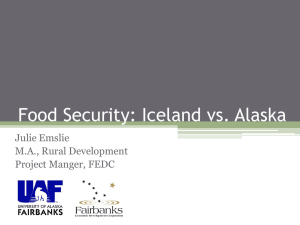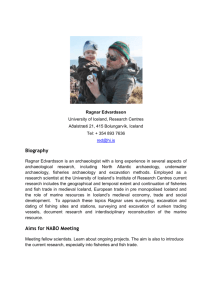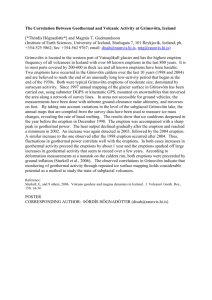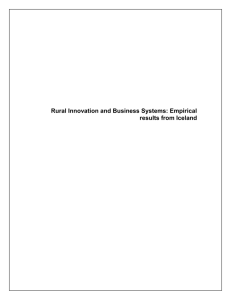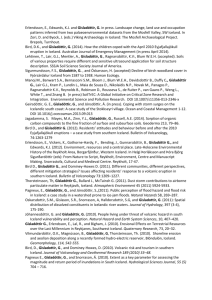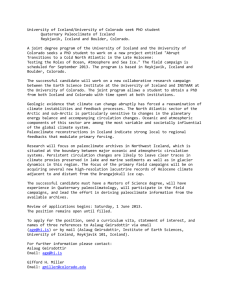Silicic Glaciovolcanism in Iceland
advertisement
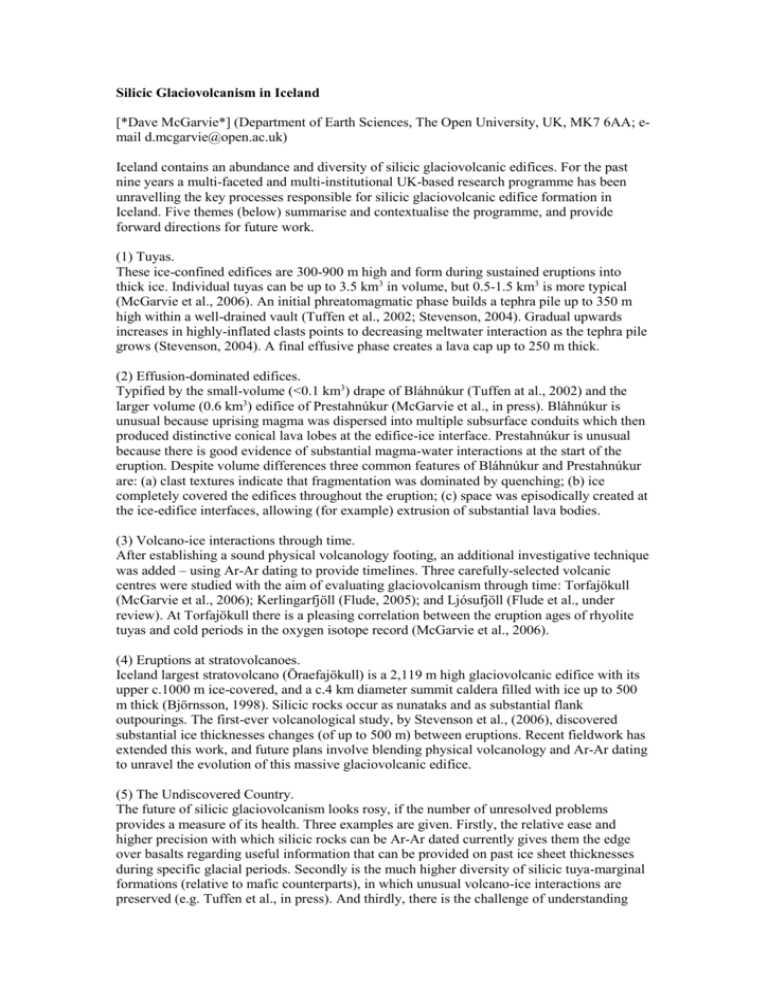
Silicic Glaciovolcanism in Iceland [*Dave McGarvie*] (Department of Earth Sciences, The Open University, UK, MK7 6AA; email d.mcgarvie@open.ac.uk) Iceland contains an abundance and diversity of silicic glaciovolcanic edifices. For the past nine years a multi-faceted and multi-institutional UK-based research programme has been unravelling the key processes responsible for silicic glaciovolcanic edifice formation in Iceland. Five themes (below) summarise and contextualise the programme, and provide forward directions for future work. (1) Tuyas. These ice-confined edifices are 300-900 m high and form during sustained eruptions into thick ice. Individual tuyas can be up to 3.5 km3 in volume, but 0.5-1.5 km3 is more typical (McGarvie et al., 2006). An initial phreatomagmatic phase builds a tephra pile up to 350 m high within a well-drained vault (Tuffen et al., 2002; Stevenson, 2004). Gradual upwards increases in highly-inflated clasts points to decreasing meltwater interaction as the tephra pile grows (Stevenson, 2004). A final effusive phase creates a lava cap up to 250 m thick. (2) Effusion-dominated edifices. Typified by the small-volume (<0.1 km3) drape of Bláhnúkur (Tuffen at al., 2002) and the larger volume (0.6 km3) edifice of Prestahnúkur (McGarvie et al., in press). Bláhnúkur is unusual because uprising magma was dispersed into multiple subsurface conduits which then produced distinctive conical lava lobes at the edifice-ice interface. Prestahnúkur is unusual because there is good evidence of substantial magma-water interactions at the start of the eruption. Despite volume differences three common features of Bláhnúkur and Prestahnúkur are: (a) clast textures indicate that fragmentation was dominated by quenching; (b) ice completely covered the edifices throughout the eruption; (c) space was episodically created at the ice-edifice interfaces, allowing (for example) extrusion of substantial lava bodies. (3) Volcano-ice interactions through time. After establishing a sound physical volcanology footing, an additional investigative technique was added – using Ar-Ar dating to provide timelines. Three carefully-selected volcanic centres were studied with the aim of evaluating glaciovolcanism through time: Torfajökull (McGarvie et al., 2006); Kerlingarfjöll (Flude, 2005); and Ljósufjöll (Flude et al., under review). At Torfajökull there is a pleasing correlation between the eruption ages of rhyolite tuyas and cold periods in the oxygen isotope record (McGarvie et al., 2006). (4) Eruptions at stratovolcanoes. Iceland largest stratovolcano (Öraefajökull) is a 2,119 m high glaciovolcanic edifice with its upper c.1000 m ice-covered, and a c.4 km diameter summit caldera filled with ice up to 500 m thick (Björnsson, 1998). Silicic rocks occur as nunataks and as substantial flank outpourings. The first-ever volcanological study, by Stevenson et al., (2006), discovered substantial ice thicknesses changes (of up to 500 m) between eruptions. Recent fieldwork has extended this work, and future plans involve blending physical volcanology and Ar-Ar dating to unravel the evolution of this massive glaciovolcanic edifice. (5) The Undiscovered Country. The future of silicic glaciovolcanism looks rosy, if the number of unresolved problems provides a measure of its health. Three examples are given. Firstly, the relative ease and higher precision with which silicic rocks can be Ar-Ar dated currently gives them the edge over basalts regarding useful information that can be provided on past ice sheet thicknesses during specific glacial periods. Secondly is the much higher diversity of silicic tuya-marginal formations (relative to mafic counterparts), in which unusual volcano-ice interactions are preserved (e.g. Tuffen et al., in press). And thirdly, there is the challenge of understanding silicic volcano-ice interactions at ice-capped stratovolcanoes such as Öraefajökull, where early indications are that new models to explain volcano-ice interactions may need to be developed. References Bjornsson, H. (1988) Hydrology of Ice Caps in Volcanic regions. Soc. Sci. Islandica. Volume 45, 139 pp, Reykjavik. Flude, S. (2005) Rhyolite volcanism in Iceland: timing and timescales of eruption. Unpublished PhD thesis, University of Manchester, UK, 257pp. Flude, S., R. Burgess and D.W. McGarvie (under review). Eruptive History of silicic volcanism at Ljosufjoll Volcano, Iceland. McGarvie DW, Burgess R, Tindle AG, Tuffen H, and Stevenson JA (2006). Pleistocene rhyolitic volcanism at the Torfajokull central volcano, Iceland: eruption ages, glaciovolcanism, and geochemical evolution. Jokull 56: 57-75. McGarvie DW, Stevenson JA, Burgess R, Tuffen H and Tindle AG (2007). Volcano-ice interactions at Prestahnukur, Iceland: rhyolite eruption during the last interglacial-glacial transition. Annals of Glaciology. In press. Stevenson, J.A. 2005. Volcano-ice interaction at Oraefajokull and Kerlingarfjoll, Iceland. Unpublished PhD thesis, The Open University, Milton Keynes, 330 pp. Stevenson, J.A., D.W. McGarvie, J.L. Smellie and J.S. Gilbert. 2006. Subglacial and icecontact volcanism at the Oraefajokull stratovolcano, Iceland. Bull. Volcanol., 68, 737-752. Tuffen, H. 2001. Subglacial rhyolite volcanism at Torfajokull, Iceland. Unpublished PhD thesis, The Open University, 381 pp. Tuffen, H., J.S. Gilbert and D.W. McGarvie 2001. Products of an effusive subglacial rhyolite eruption: Blahnukur, Torfajokull, Iceland. Bull. Volcanol 63, 179-190. Tuffen, H., D.W. McGarvie, J.S. Gilbert and H. Pinkerton 2002. Physical volcanology of a subglacial-to-emergent rhyolitic tuya at Raudfossafjoll, Torfajokull, Iceland. Geological Society, London, Special Publications, 202, 213-236. Tuffen, H., D.W. McGarvie., H. Pinkerton., J.S. Gilbert., J.A. Stevenson and R. Brooker. (2007). An explosive-intrusive subglacial rhyolite eruption at Dalakvisl, Raudufossafjöll, Iceland. Bulletin of Volcanology (in press). INVITED ORAL CORRESPONDING AUTHOR: DAVE McGARVIE



